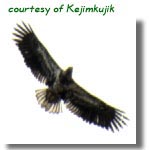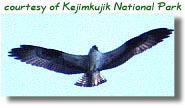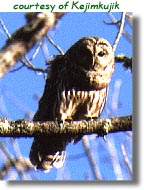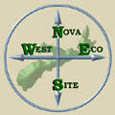Bald Eagle Haliaeetus leucocephalus
 These
birds are very large, about 30 to 43 inches from head to tail. The Bald Eagle is mainly
brown in colour with a white head and tail and a short, hooked, yellow bill. Immature eagles
have a dark head and tail with a black bill. After being fledged, young eagles are more
prone to travel abroad than adults. The sound of a Bald Eagle is not as loud as birds such
as the Herring Gull; rather their sound is a series of curt, short rapid notes. Bald
Eagles are relatively shy birds that prefer seashores, wetlands, or remote forested areas.
Their nests are usually made in huge, tall trees. The migratory habits of these
creatures are not strongly ingrained. This bird is mainly a permanent, or stay-resident
bird, and even more so as it gets older. The eagle's diet consists mainly of
fish or carrion and thus they can be found around estuaries. Contrary to popular belief,
these birds are not usually predatory by nature. They prefer to scavenge rather than
kill. They generally lay two or three eggs in April. Pesticide poisoning had
caused a sharp decline in the population of Bald Eagles, but they have increased gradually
in population in recent years, with the Nova Scotia population recovering at a quicker
rate than other areas. Due to the number of Bald Eagles in Nova Scotia, our
population has been used to help reintroduce or repopulate other areas across North
America.
These
birds are very large, about 30 to 43 inches from head to tail. The Bald Eagle is mainly
brown in colour with a white head and tail and a short, hooked, yellow bill. Immature eagles
have a dark head and tail with a black bill. After being fledged, young eagles are more
prone to travel abroad than adults. The sound of a Bald Eagle is not as loud as birds such
as the Herring Gull; rather their sound is a series of curt, short rapid notes. Bald
Eagles are relatively shy birds that prefer seashores, wetlands, or remote forested areas.
Their nests are usually made in huge, tall trees. The migratory habits of these
creatures are not strongly ingrained. This bird is mainly a permanent, or stay-resident
bird, and even more so as it gets older. The eagle's diet consists mainly of
fish or carrion and thus they can be found around estuaries. Contrary to popular belief,
these birds are not usually predatory by nature. They prefer to scavenge rather than
kill. They generally lay two or three eggs in April. Pesticide poisoning had
caused a sharp decline in the population of Bald Eagles, but they have increased gradually
in population in recent years, with the Nova Scotia population recovering at a quicker
rate than other areas. Due to the number of Bald Eagles in Nova Scotia, our
population has been used to help reintroduce or repopulate other areas across North
America.
Osprey Pandion haliaetus
The osprey is the provincial bird for Nova Scotia. A relatively large predator bird,
measured at 22 to 25 inches in length from head to tail, with a brown back and white underbody. The
Osprey's head is predominantly white with a brown line running up the base of the neck
through its eyes. Ospreys' colours are more speckled when younger. This bird is
comparatively louder than other birds with a "kip kip ki-yeuk, ki-yeuk" as described
by the National Audubon Society. Nesting habits are unusual. Construction and protection
of nests by this bird is underrated: Ospreys tend to use man-made poles or towers for
nesting, and are not as protective of eggs as they are of hatched offspring. Nests are
always very high off the ground. Two to four eggs are usually produced sometime in May to
June. Inland bodies of water or coastlands are where Ospreys are mainly found. Fish are their main diet and the population of the Osprey suffered a sharp decline a few years ago due to
contaminated fish--just like the Bald Eagle. The northern breeding limits are from Alaska
to Newfoundland. The southern breeding limits lie within Nova Scotia. On the western
side of North America, the breeding range of the Osprey extends from Yukon all the way
down to a fair number of the western United States, but gradually narrows down as it
progresses across North America to Newfoundland and Nova Scotia. The wintering range,
however, only includes the Southeastern coastline of the United Studies of America.
underbody. The
Osprey's head is predominantly white with a brown line running up the base of the neck
through its eyes. Ospreys' colours are more speckled when younger. This bird is
comparatively louder than other birds with a "kip kip ki-yeuk, ki-yeuk" as described
by the National Audubon Society. Nesting habits are unusual. Construction and protection
of nests by this bird is underrated: Ospreys tend to use man-made poles or towers for
nesting, and are not as protective of eggs as they are of hatched offspring. Nests are
always very high off the ground. Two to four eggs are usually produced sometime in May to
June. Inland bodies of water or coastlands are where Ospreys are mainly found. Fish are their main diet and the population of the Osprey suffered a sharp decline a few years ago due to
contaminated fish--just like the Bald Eagle. The northern breeding limits are from Alaska
to Newfoundland. The southern breeding limits lie within Nova Scotia. On the western
side of North America, the breeding range of the Osprey extends from Yukon all the way
down to a fair number of the western United States, but gradually narrows down as it
progresses across North America to Newfoundland and Nova Scotia. The wintering range,
however, only includes the Southeastern coastline of the United Studies of America.
Sharp-Shinned Hawk Accipiter striatus
The Sharp-Shinned Hawk is one of North America's smaller hawks, measuring an average of
14 inches from head to tail. Adults have a slate-grey cap tapering up from the back to
just above the beak, with a brown-barred white breast. Tails are square with thick,
reddish-brown bars. Eyes change from yellow to red when this bird reaches
maturity. When general shape is compared, the identification of the Sharp-shinned
Hawk could possibly be confused with the Red-Tail Hawk. However, a comparison of
colours yields unique characteristics, because the Red Tail Hawk has a white breast and
solid rusty red tail. The Red-Tail Hawk can usually be seen perched in trees bordering an open
habitat, such as a field or roadside. When the Sharp-Shinned
hawk is in the immature stage, the back and head tend to be brown, the bars across the
white breast are inclined to be more red than brown, but the colours of the tail remain the
same. This hawk is mainly found in woodland areas, particularly within what the Museum of
Natural History defines as an edge habitat. Four broader habitat patterns converge
in the Sharp-Shinned Hawk's living environment: mixed stands of coniferous and deciduous
trees, with an open clearing, all within a mountainous coastal region. The breeding range
encompasses all of North America. Wintering migration includes all of the United States to
Central America, and occurs between September and October. Breeding occurs from early
spring to late summer. Nests are located at a moderate distance of four to ten meters up
from the ground. Gestation or laying period takes place between March and May, with
hatchings between April and June, with an average of four eggs being produced.
Barred Owl Strix varia
 Size places
this raptor in the slightly above average proportion of all birds at 21 inches from head
to tail. Overall, these owls are grey and brown, with brown bars on their back and head.
Easily identifiable because it is the only black-eyed owl in Nova Scotia. The head
is round with no ear tufts. The breast is vertically striped with light brown strips.
The collar is horizontally striped, likewise brown. The call of the Barred Owl is fairly long
ending in a high note. In his book Birds of Nova Scotia, Robie Tufts defined the
call as "whoo-whoo-whoo-who-whoo-to-whoo-ah". In his book An Audubon
Handbook, John Farrand defines the call as "Who-cooks-for-you,
who-cooks-for-you-all?" The Barred Owl prefers mixed old wood stands in a swampy area. Most migrations tend to cluster on the eastern
half of North America, but the Barred Owl's migrations extend to the western coast and not
much further north or south. Laterally speaking, the Barred Owl reaches Erskine's northern
breeding limit in the Maritimes. Nests are usually located four to twelve meters high
in a tree and may contain, at most, three eggs. Gestation or laying period is early April
to late May.
Size places
this raptor in the slightly above average proportion of all birds at 21 inches from head
to tail. Overall, these owls are grey and brown, with brown bars on their back and head.
Easily identifiable because it is the only black-eyed owl in Nova Scotia. The head
is round with no ear tufts. The breast is vertically striped with light brown strips.
The collar is horizontally striped, likewise brown. The call of the Barred Owl is fairly long
ending in a high note. In his book Birds of Nova Scotia, Robie Tufts defined the
call as "whoo-whoo-whoo-who-whoo-to-whoo-ah". In his book An Audubon
Handbook, John Farrand defines the call as "Who-cooks-for-you,
who-cooks-for-you-all?" The Barred Owl prefers mixed old wood stands in a swampy area. Most migrations tend to cluster on the eastern
half of North America, but the Barred Owl's migrations extend to the western coast and not
much further north or south. Laterally speaking, the Barred Owl reaches Erskine's northern
breeding limit in the Maritimes. Nests are usually located four to twelve meters high
in a tree and may contain, at most, three eggs. Gestation or laying period is early April
to late May.



